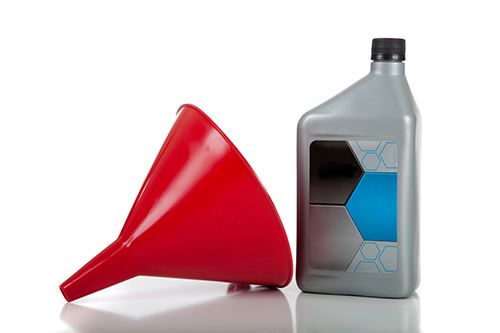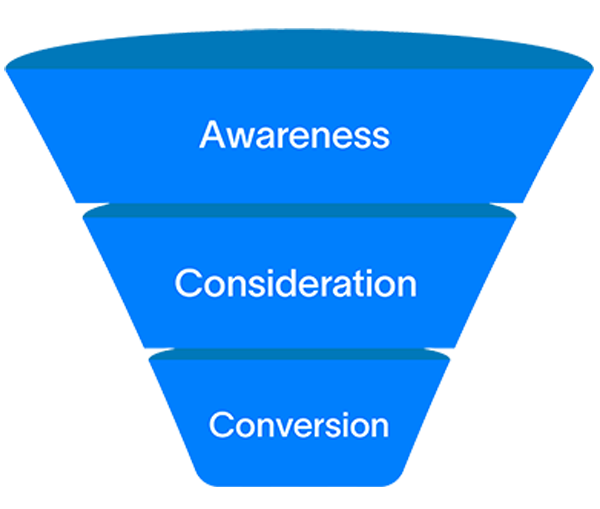When’s the best time to reach potential customers? When they need something fixed and they’re ready to hire a home services professional like yourself?
Wrong. The answer is all the time.
I’ll explain what I mean by discussing the concept of the marketing funnel. When you think of the marketing funnel, picture a funnel that you would use to add oil into your car.

The marketing funnel looks just like this. It represents the typical customer journey and how you should market to customers in each stage of that journey.
While there are many theories out there regarding the different layers that make up the marketing funnel, they all effectively boil down to these three layers:

These are the stages a consumer moves through in their journey of becoming a new customer. Just like the funnel you use for changing your oil, the marketing funnel is at its widest point at the top and progressively gets smaller as you move down. This represents the fact that you’ll start with a broad audience when you market to customers who are the top of the funnel (those who are just starting their customer journey), and that audience will get smaller and smaller as you target more serious prospects (those who are ready to hire a professional).
To be visible in all three layers of the customer journey, you must have a full-funnel marketing strategy — especially considering that people tend to engage with a business numerous times before deciding to use their services.
Implementing a full-funnel marketing strategy can help you to put your business in the best position to stay in front of customers and bring in more of the jobs you want.
A breakdown of the marketing funnel’s three layers
To help you better understand the consumers’ mindset in each stage of their purchase journey (and how to best appeal to them at these times), here’s a breakdown of each of the marketing funnel’s three layers. As you’ll see, the consumer’s level of intent to make a purchase decision increases as they move down the funnel.
Awareness: Low Intent
The awareness level is the top of the funnel where the initial point of contact happens with the consumer. They may not even know that they need your service or who you are, but your company is becoming visible to them. The first step to gaining a customer is to make sure they know you exist!
Some examples of top-of-the-funnel advertising include:
- Social media campaigns (Facebook, Instagram, Twitter, etc.)
- Video marketing and advertising (YouTube and Facebook)
- Blog posts
- Billboards
- Radio spots
- TV ads
The goal of awareness is to build your company’s brand by being visible on all different types of platforms. It’s well-documented that when it comes time for a consumer to make a purchasing decision, they’re more likely to choose a business or brand that they’re already familiar with. Being active and visible to potential customers before they ever need your help will boost the success of your business long-term.
Consideration: Medium Intent
This is the middle of the funnel. At this stage, the potential customer knows they have an issue and are looking for specific solutions. They also may already be aware of your business (due to the visibility you created for your business with an upper-funnel marketing strategy), and now they are considering whether your company is the best choice. The consideration phase is also known as the research phase.
Common mid-funnel strategies include:
- Targeted content marketing through social media outlets
- Email campaigns
- Product information
- Specials and coupons
- Word of mouth referrals
- Reviews
Your goal during the consideration stage is to make sure your business stands out compared to the next one. You need to be able to communicate why your company is better than the rest.
Conversion: High Intent
This is the bottom of the funnel where the person searching has the highest intent to book a job. They have completed all their research and are ready to hire you for your services.
High-intent consumers are likely to respond well to:
- Google paid ads (pay-per-click ads that appear in the search results)
- Branded search ads (ads that appear when someone searches for your business by name)
- Display ads (ads that appear while people are browsing other websites)
- Remarketing ads (ads that appear to people who have already visited your site)
- Local Services Ads (the “Google Guaranteed” ads that show up at the top of the search results)
The goal of conversion is exactly what it sounds like: to convert the consumer from a prospective customer into a paying customer.
Using the funnel to attack weather changes
The home services industry is heavily impacted by seasonality, so it’s important to be in front of potential customers as much as possible year-round. If someone sees your trucks, billboards, or Facebook ads all the time as part of their day-to-day life, they will be much more comfortable contacting your business when the time comes for them to hire a home services professional.
Let’s look at the HVAC industry as an example…
As we close out the summer and move into fall, the HVAC busy season is about to come to an end, which means we’ll see search volumes for HVAC services considerably drop.
What are you doing to keep potential customers aware of your company during this time when they’re likely not seeking out your services? This is where a full-funnel marketing strategy will help to keep you visible and memorable.
If you’re not doing awareness-focused ads on social media, publishing helpful blogs, or advertising your business on TV or the radio, one of your competitors will be. By the time the cold season hits, the customer will already know who they’re going to call. Make sure they will be calling your business!



